|
People

The events of February 29, 1704, and their aftermath, affected not only those present at the raid, but hundreds of others as well. Of the many people whose lives intersected with this event, here are some whose stories have survived. Click a person's image or name to view his or her story.
For an explanation of how we created these people narratives, see:
Bringing History to Life: The People in The Many Stories of 1704.
For brief biographies of people at the Raid on Deerfield for whom we have historical documentation, see:
People of the Raid on Deerfield: Brief Biographies.
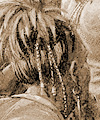 |
Aronhiatehka, circa 1653 - circa 1726, Kanienkehaka
Like many Kanienkehaka in the 17th century, Aronhiatehka left the southern part of the Kanienkehaka homeland to settle at its northern borders at Kahnawake. He became a chief who was active in negotiating the Great Peace of 1701 among his people. |
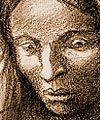 |
Atiwans, circa 1661 - circa 1748, Sokoki - Wôbanaki
Atiwans, a Sokoki man who married a Pocumtuck woman, spent much of his life between the Connecticut River valley and Schaghticoke, before relocating north. He was one of three captors of the Reverend John Williams in 1704. |
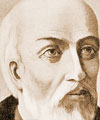 |
Jean de Brébeuf, circa 1593 - circa 1649, French
Jean de Brébeuf was one of the first Jesuit missionaries
to the Wendat (Huron) confederacy and was instrumental in maintaining
trade and military alliances between the Wendat and the French. |
 |
Jacques Bruyas, 1635 - 1712, French
Father Jacques Bruyas, a French Jesuit missionary, spent many years among the Rotinonsionni (Iroquois). He wrote a dictionary, grammar and catechism in Kanienkeha (the Mohawk language), and helped negotiate the Great Peace of 1701. |
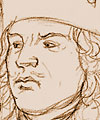 |
Louis-Hector de Callière, 1648 - 1703, French
Louis Hector de Callière, governor-general of New France from 1699 to 1703, achieved a diplomatic success in concluding the Great Peace of 1701 between New France and 38 Native nations. |
 |
Samuel de Champlain, circa 1567 - 1635, French
Known as the Father of New France, Samuel de Champlain spent
the last years of his life ensuring the success of the colony.
|
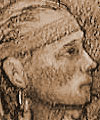 |
Chauk, circa 1618 - circa 1700, Podunk - Wôbanaki
Chauk, a Podunk Indian from around Windsor, CT, was the first Native person to sign a deed opening Pocumtuck lands around Deerfield to the English.
|
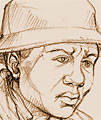 |
Frank, circa 1661 - 1704, African - English
Frank was the Reverend John Williams's African slave, who survived the attack on Deerfield, only to be taken captive with his master's family. |
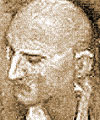 |
Hatsirohawi, circa 1669 - circa 1748, Kanienkehaka
Hatsirohawi was a Kanienkehaka trader trying to negotiate between
"two worlds." |
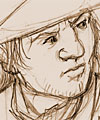 |
John Hawks, 1643 - circa 1722, English
John Hawks was involved in several conflicts with local Native peoples as English settlement pushed northward up the Connecticut River valley. |
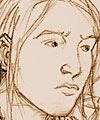 |
Jonathan Hoyt, 1688 - 1779, English
Jonathan Hoyt was 15 years old when taken captive in 1704, and for a time, his life hung in the balance as his captors discussed his fate. |
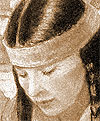 |
Mashalisk, circa 1591 - circa 1676, Pocumtuck - Wôbanaki
Mashalisk was a Pocumtuck sunksqua from the east side of the Connecticut River who tried to negotiate peaceful trade with the English. She signed deeds for present-day Montague, Leverett and Wendell, Massachusetts, to cover her son Wattawaluncksin's trading debts. |
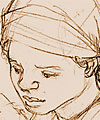 |
Parthena, circa 1682 - 1704, African - English
Parthena was a newly married slave working in the Reverend John Williams's household at the time of the attack in 1704. |
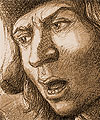 |
Jean-Baptiste Hertel de Rouville, 1668 - 1722, French
Lieutenant Jean-Baptiste Hertel de Rouville led the raiding party in the attack on Deerfield in 1704. |
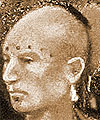 |
Soranhes, circa 1588 - circa 1636, Wendat
Soranhes, a skilled Wendat trader, befriended French priests
in hopes of improving his relationship with French authorities
and, thus, his trading prospects. |
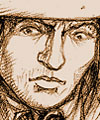 |
Benoni Stebbins, circa 1655 - 1704, English
Benoni Stebbins had many encounters with Native people of the Connecticut River valley. His life ended as he defended his house and its occupants during the 1704 attack. |
 |
Thaonwentsawakon, circa 1683 - circa 1748, Kanienkehaka
Thaonwentsawakon came to Deerfield from Kahnawake in search of a child for his sister to adopt. |
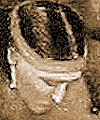 |
Tsioianiio, circa 1692 - circa 1769, Kanienkehaka
Tsioianiio was a Kanienkehaka girl who befriended Eunice Kanenstenhawi
Williams and eased her transition to life at Kahnawake. |
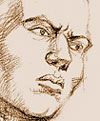 |
Tsohahisen, circa 1679 - circa 1750, Wendat
Tsohahisen was a young Wendat who, on the return to New France in 1704, skillfully negotiated a resolution to a dispute over a captive. |
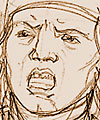 |
Captain William Turner, circa 1623 - 1676, English
Captain William Turner was a Massachusetts Bay military leader from Boston, who led the English attack on Peskeompskut, a Native fishing camp. |
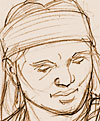 |
Umpanchela, circa 1604 - circa 1704, Nonotuck - Wôbanaki
Umpanchela, alias Womscom, was a Nonotuck sachem who had a large trading account with John Pynchon, and signed off on deeds for land that is now Amherst, Hatfield, Hadley, and Northampton, Massachusetts. |
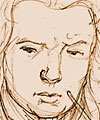 |
Philippe de Rigaud de Vaudreuil, circa 1643 - 1725, French
Philippe de Rigaud de Vaudreuil, governor-general of New France from 1703 to 1725, pursued a strategy of attacking New England with combined French and Native armies. For a decade during and after the War of the Spanish Succession, he was involved in negotiations with the English over the fate of captives taken in such attacks. |
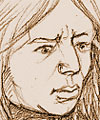 |
Wattanummon, circa 1660 - 1712, Pennacook - Wôbanaki
Wattanummon, a Pawtucket man who served as a Pennacook sachem, requested Governor Vaudreil's help after the English killed his kin at Pequawket. He joined the raid on Deerfield, and personally captured the minister's son, Stephen Williams. |
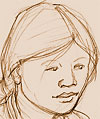 |
Weetanusk, circa 1653 - circa 1736, Pocumtuck - Wôbanaki
Weetanusk, as a young girl, watched her grandmother Mashalisk manage diplomatic relations with the English. As a young woman, she survived the attack at Peskeompskut and relocated to Schaghticoke. |
 |
Eunice Kanenstenhawi Williams, 1696 - 1785, English / Kanienkehaka
Taken captive in 1704, seven-year-old Eunice Williams was adopted into a Kanienkehaka (Mohawk) family, where she remained for the duration of her life. |
 |
Eunice Mather Williams, 1664 - 1704, English
Eunice Mather Williams, wife of the Reverend John Williams, was weak from recent childbirth when she was captured in 1704. |
 |
Reverend John Williams , 1664 - 1729, English
In 1704, the minister of Deerfield, along with his wife and several of his children, was taken captive to Canada. Upon his return to New England, he wrote the famous narrative The Redeemed Captive Returning to Zion. |
 |
Stephen Williams, 1693 - 1782, English
Ten-year-old Stephen Williams, taken captive by the Wôbanakiak, found himself to be unsuited for life as a Wôbanaki boy; he eventually followed his father's steps into the ministry. |
|
![]()
![]()



























